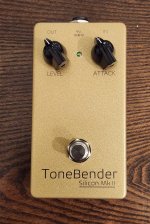So I have been experimenting (at reasonably loud household volume) with a silicon bender on my bread board the past few weeks. I started with the widely recognized GGG / Orman / RDV TBii schematic: https://generalguitargadgets.com/pdf/ggg_tb_m2p_sc_ns.pdf
Comparing it with the Carbon Black (EDQ Black Ash) https://docs.pedalpcb.com/project/CarbonBlack.pdf (other than transistor choice, Fuzz pot, and the "Top" control), I find several differences:
Q1 emitter resistor on GGG (R11) is 2K7, on Carbon Ash (R5) is 4K7
Q2 emitter resistor on GGG (R12) is 100 Ohm, on Carbon Ash (R7) is 1K
Q3 emitter resistor on GGG (R13) is 220 Ohm, absent on Carbon Ash
Q3 collector resistor / voltage divider pair are 1K (R5) / 20Ktrim (R6) on GGG, 22K (R8) / 10K trim on Carbon Ash
In my own trial and error experiments ( I do not have a scope, nor do I understand SPICE or EE enough to use it) I find I am able to eliminate both the 100 Ohm and 220 Ohm resistors and the effect is fully operational - though I do see the emitter resistors can impact voltage and biasing.
I am using 2N4123 / 2N2369 / BD139 or 2N2369 with hFE all between 75 and 90. I am able to dial in pretty much any voltage on Q3 from over 8 to starving and anything in between. To my ear so far, I *think* I am dialing into the 6.5-7.25ish range as my preference. I have set Q1 anywhere between 7-8v and notice it sounds more touch-sensitive (microphonic?) as I approach 8v and above, which I assume is normal.
So enough backstory, to my questions:
I understand the 100 and 220R emitter resistors (as well as the larger one on Q1e) are to reduce gain, but if they are "seemingly" not needed, is there any less apparent value to them? Conversely, why does the Carbon Black use one 10x larger than GGG?
Do they offer better stability, more useful biasing flexibility etc., or can I / should I remove them since my Q2/Q3 are tolerant of them not being in circuit?
As to the GGG R5 1K/R6 20K trim Carbon R8/10K trim pair -- GGG provides for a total series resistance range from 1K - 21K, while Carbon Black only starts its range with a fixed 22K in place of GGG's 1K, and then adds the 10K trimmer.
Understanding the 1K is the silicon equivalent for classic Ge circuit's ~470 Ohm, and an increased value increases output level, is the 22K then simply providing output on steroids?
As I continue to experiment with the circuit (love it so far) I am trying to more closely understand what I am doing, so any insight is greatly appreciated.
Comparing it with the Carbon Black (EDQ Black Ash) https://docs.pedalpcb.com/project/CarbonBlack.pdf (other than transistor choice, Fuzz pot, and the "Top" control), I find several differences:
Q1 emitter resistor on GGG (R11) is 2K7, on Carbon Ash (R5) is 4K7
Q2 emitter resistor on GGG (R12) is 100 Ohm, on Carbon Ash (R7) is 1K
Q3 emitter resistor on GGG (R13) is 220 Ohm, absent on Carbon Ash
Q3 collector resistor / voltage divider pair are 1K (R5) / 20Ktrim (R6) on GGG, 22K (R8) / 10K trim on Carbon Ash
In my own trial and error experiments ( I do not have a scope, nor do I understand SPICE or EE enough to use it) I find I am able to eliminate both the 100 Ohm and 220 Ohm resistors and the effect is fully operational - though I do see the emitter resistors can impact voltage and biasing.
I am using 2N4123 / 2N2369 / BD139 or 2N2369 with hFE all between 75 and 90. I am able to dial in pretty much any voltage on Q3 from over 8 to starving and anything in between. To my ear so far, I *think* I am dialing into the 6.5-7.25ish range as my preference. I have set Q1 anywhere between 7-8v and notice it sounds more touch-sensitive (microphonic?) as I approach 8v and above, which I assume is normal.
So enough backstory, to my questions:
I understand the 100 and 220R emitter resistors (as well as the larger one on Q1e) are to reduce gain, but if they are "seemingly" not needed, is there any less apparent value to them? Conversely, why does the Carbon Black use one 10x larger than GGG?
Do they offer better stability, more useful biasing flexibility etc., or can I / should I remove them since my Q2/Q3 are tolerant of them not being in circuit?
As to the GGG R5 1K/R6 20K trim Carbon R8/10K trim pair -- GGG provides for a total series resistance range from 1K - 21K, while Carbon Black only starts its range with a fixed 22K in place of GGG's 1K, and then adds the 10K trimmer.
Understanding the 1K is the silicon equivalent for classic Ge circuit's ~470 Ohm, and an increased value increases output level, is the 22K then simply providing output on steroids?
As I continue to experiment with the circuit (love it so far) I am trying to more closely understand what I am doing, so any insight is greatly appreciated.
Last edited:


